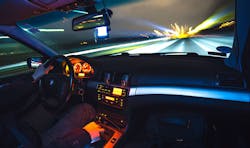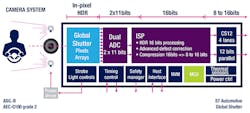Global-Shutter Sensors Enhance Driver and Passenger Monitoring
Safety organizations worldwide agree that driver fatigue is a serious problem that results in many thousands of road accidents each year. Research shows that driver fatigue may be a contributory factor in 20% or more of road accidents, and up to one quarter of fatal and serious accidents.
Enhanced driver monitoring using image sensors can reduce injuries and save lives. For this reason, in its 2025 Roadmap, which outlines a timeline for the introduction of key protocol enhancements, the European New Car Assessment Programme (Euro NCAP, backed by several European governments, as well as by the European Union) has proposed driver monitoring as among its highest-priority primary-safety features.
So, the question isn’t what needs to be done. Rather, it’s how to best do it.
STMicroelectronics believes it has an answer. The company unveiled two new automotive image sensors, the VG5661 1.6-Mpixel and VG576 2.3-Mpixel automotive global-shutter sensors that are specifically developed for driver monitoring. Unlike the more typical rolling shutter, which continuously reads data directly from pixels one row at a time, global shutters capture the data at all pixels simultaneously. This is particularly beneficial when the image is changing from frame to frame.
Block diagram of the VG5661 global-shutter sensor. (Source: STMicroelectronics)
ST’s automotive global-shutter technology is also said to minimize the illumination power consumption, even in high dynamic range mode. The sensors enhance monitoring of vehicle occupants by capturing the scene and eliminating unpredictable external effects such as sunlight or street lighting. According to ST, the sensors’ image quality sharpens the responses of driver-monitoring systems, especially under near-infrared illumination close to 940 nm, and they make possible new features such as assessing driver attention, passenger comfort, or child behavior.
These imagers take advantage of a unique automotive global-shutter pixel with two memory cells while keeping a small pixel size of 3.2 μm, resulting in compact sensors, and higher resolution that capture sharp images in challenging conditions. Two memory zones allow for double-image storage, enabling linear high dynamic range up to 98 dB or background removal without lag effects and with no need for additional processing by the host system. This offloads the host processor and reduces instances of correction artefacts. In addition, high dynamic range and high MTF (modulation transfer function) at near-infrared wavelengths further minimizes interference from natural light sources.
ST’s automotive global-shutter sensor product family features both high dynamic range (HDR) video and low noise where crosstalk is minimized. The sensing accuracy of these imagers is said to help autonomous-driving systems assess a human driver’s fitness to take over any time during a journey, easing transitions between manual and autonomous driving modes.
Both imagers were demonstrated with automotive software supplier Jungo’s driver-monitoring solution CoDriver, at the AutoSens Imaging conference and at Electronica 2018. Jungo’s driver-monitoring software leverages the images from ST’s sensors to monitor the position and movements of all occupants, assessing the driver’s condition and accurately surveying the location and movements of other vehicle occupants. The demonstration highlighted opportunities to improve interactions between autonomous and human drivers, and showed how passenger monitoring expands opportunities to enhance comfort and security.
Ophir Herbst, CEO of Jungo, noted, “Our software-based solution, combined with the outstanding background-removal and moving-image capture capabilities of ST’s sensors, enables affordable, high-performance driver monitoring and creates a powerful, flexible platform for new features and services in the vehicles of the future.”
The VG5661 and VG5761 are supplied in standard BGA packages or as bare die for direct integration in automotive OEM systems produced in high volumes. They are qualified to AEC-Q100 grade 2 and include complex safety-integrity features as required for an ASIL-B camera system in accordance with the automotive safety standard ISO 26262.


